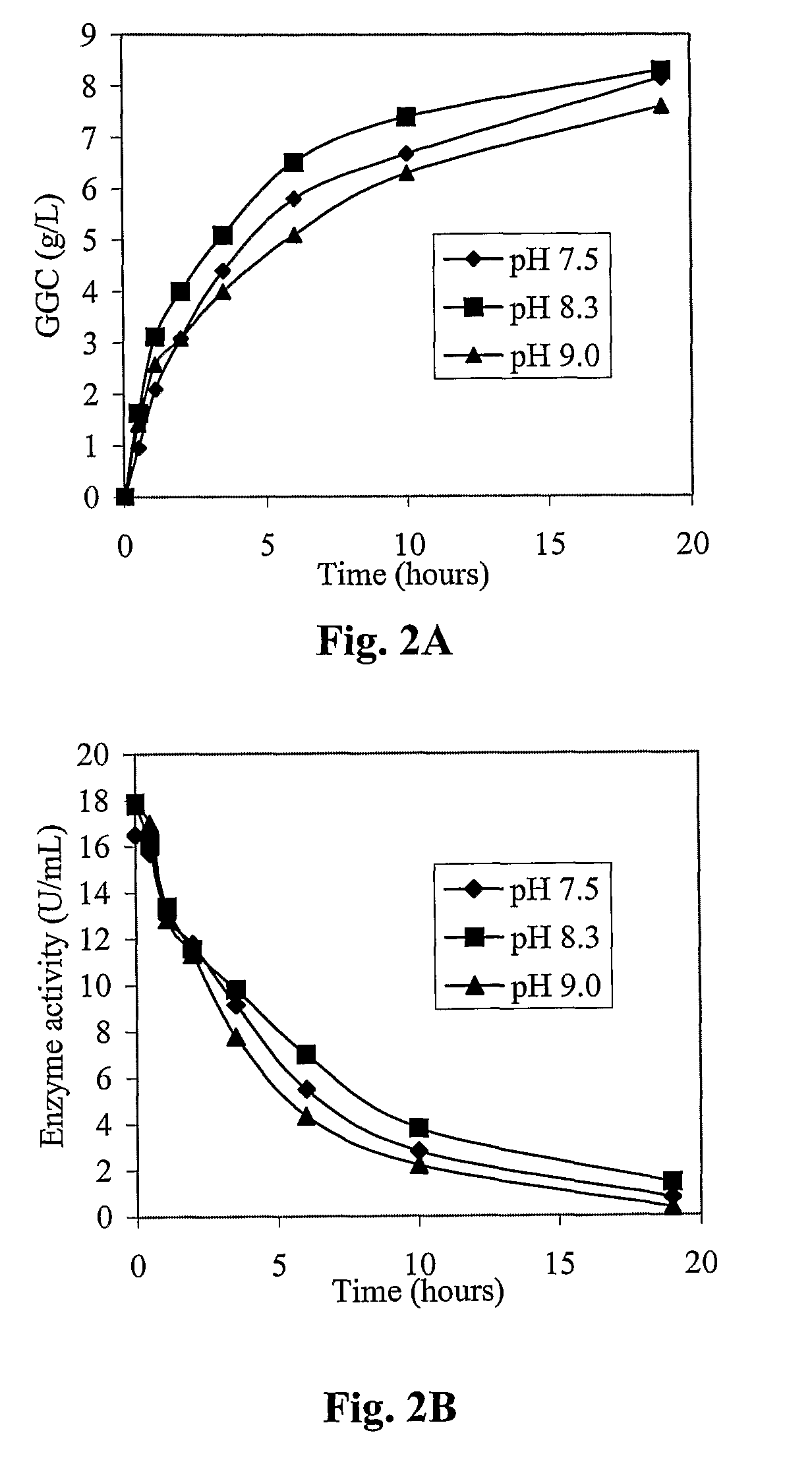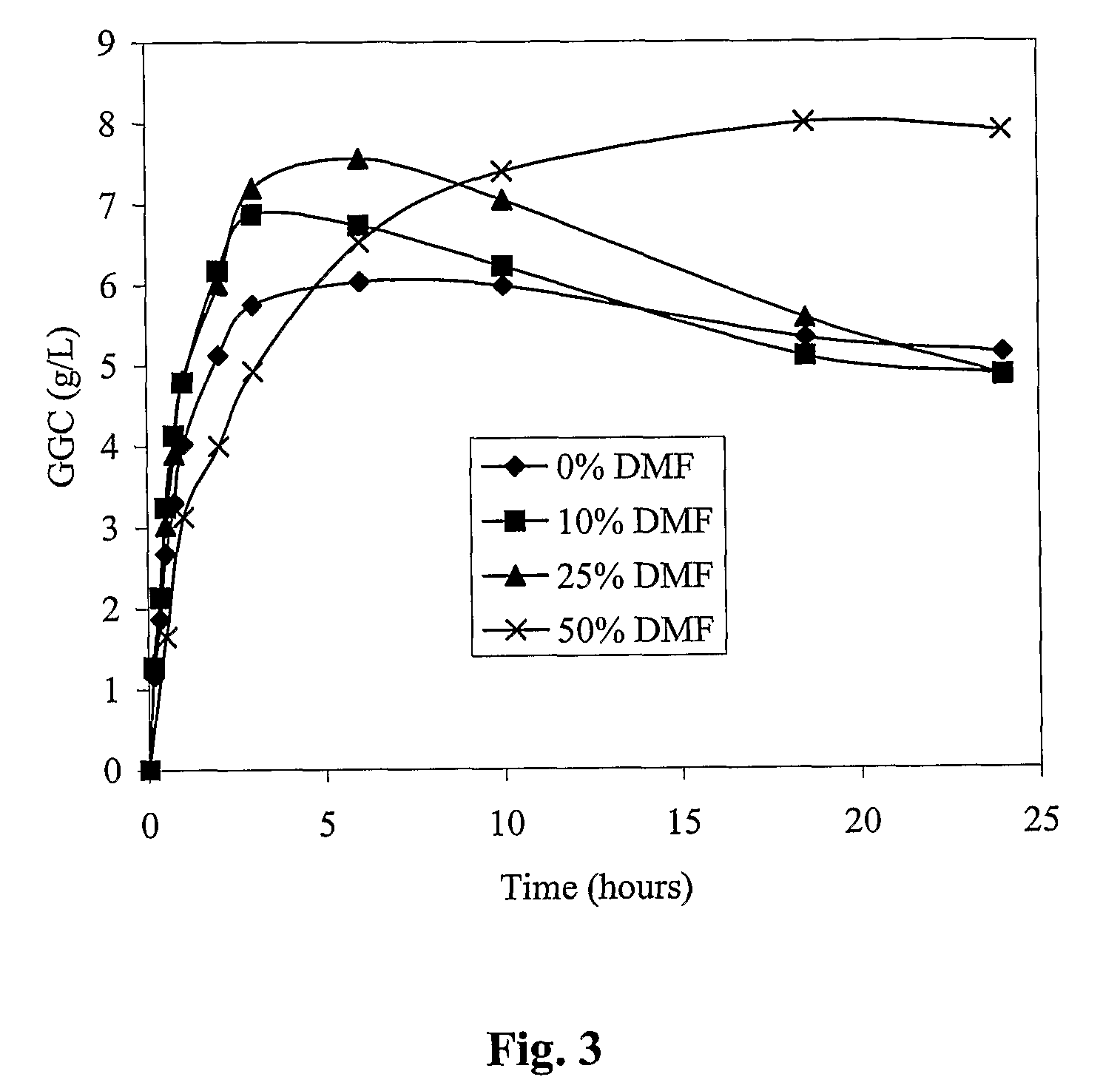Process for the production of γ-glutamylcysteine
a technology of -glutamylcysteine and -glutamylcysteine, which is applied in the direction of hydrolases, biochemical apparatus and processes, enzymes, etc., can solve the problems of ineffective gsh synthesis, ineffective gsh synthesis, and ineffective administration of cysteine, the limiting amino acid of gsh synthesis, etc., to achieve a relatively simple and cost-effective process, the effect of efficien
- Summary
- Abstract
- Description
- Claims
- Application Information
AI Technical Summary
Benefits of technology
Problems solved by technology
Method used
Image
Examples
example 1
Materials and Methods
1.1 HPLC Sample Preparation
[0216]Acid stopped enzyme reaction mixture (100 μL) was diluted into 0.1 M K2HPO4 (900 μL) and an aliquot (250 μL) dispensed into an Eppendorf tube containing 0.2 M mercaptoethanol in the same buffer (250 μL). The tube was incubated at 37° C. for 20 minutes to reduce all disulphides, and excess mercaptoethanol was removed by extraction with 3 aliquots of ethyl acetate (750 μL). The sample was diluted appropriately in HPLC mobile phase and stored at 4° C. ready for injection onto the HPLC.
1.2 Thiol Determination Using HPLC
[0217]Thiols were separated using a Shimadzu (Class VP) HPLC system with an Alltima (Alltech) C18, 5 μm, (250×4.6 mm) column (P / N 88057). Isocratic elution was performed with a mobile phase consisting of 0.1 M potassium dihydrogen phosphate, 0.35% acetonitrile (v / v) adjusted to pH 3.0 with 85% (w / v) phosphoric acid at a flow rate of 1 ml / min. Thiols were measured by electrochemical detection with a Coulochem II (ESA, B...
example 2
Synthesis of γ-Glutamylcysteine (GGC) with Amide Bonded γ-Glutamyl Donor
[0255]Cystine (36 mg, 3 mM) was dissolved with warming in 50 mM sodium phosphate buffer (50 mL) at pH 8.5. An aliquot (10 mL) was dispensed into a test tube containing L-γ-glutamyl-p-nitroanilide (GPNA) (4 mg, 1.5 mM) and pH adjusted to pH 8.5 with 10% NaOH. The tube was incubated at 37° C. and the reaction initiated by the addition of γ-GT (3 mg, 2.2 U / mL). Samples (0.5 mL) were taken at 15, 30 and 90 minute intervals, with the reaction quenched by the addition of an equal volume of 4.5% (w / v) phosphoric acid. Samples were stored at −20° C. prior to HPLC analysis. After 90 min incubation the reaction contained 156 mg / L GGC at yields based on the theoretical maximum of 21% on cystine and 42% on GPNA. The reaction as described above was repeated at 5.5 times the original concentration of substrates (cystine; 16.6 mM, GPNA 8.4 mM) which corresponded to the solubility limits of both GPNA and cystine at pH 8.5 in 10...
example 3
Synthesis of γ-Glutamylcysteine (GGC) with Ester Bonded γ-Glutamyl Donors
[0257]The synthesis of GGC with L-glutamine and γ-glutamyl esters as γ-glutamyl donors was performed in aqueous solution. Cystine (50 mg, 20 mM) was added separately to glutamine (14.6 mg, 10 mM) and glutamic acid γ-methyl ester (GME) (16 mg, 10 mM) in test tubes. The contents of each tube was dissolved in 100 mM sodium phosphate buffer (10 mL) and adjusted to pH 8.5 with 2 M NaOH. The reaction was initiated by the addition of γ-GT (3 mg, 2.2 U / mL) and the tubes were incubated at 37° C. with samples taken periodically over 24 hours. The yields of GGC peaked at approximately five hours incubation with 78.4 mg / L of GGC produced with GME at a yield (based on the γ-glutamyl donor) of 3.1% and 1.5 mg / L GGC produced with glutamine at a yield of less than 1%.
PUM
| Property | Measurement | Unit |
|---|---|---|
| miscible | aaaaa | aaaaa |
| pH | aaaaa | aaaaa |
| pH | aaaaa | aaaaa |
Abstract
Description
Claims
Application Information
 Login to View More
Login to View More - R&D
- Intellectual Property
- Life Sciences
- Materials
- Tech Scout
- Unparalleled Data Quality
- Higher Quality Content
- 60% Fewer Hallucinations
Browse by: Latest US Patents, China's latest patents, Technical Efficacy Thesaurus, Application Domain, Technology Topic, Popular Technical Reports.
© 2025 PatSnap. All rights reserved.Legal|Privacy policy|Modern Slavery Act Transparency Statement|Sitemap|About US| Contact US: help@patsnap.com



